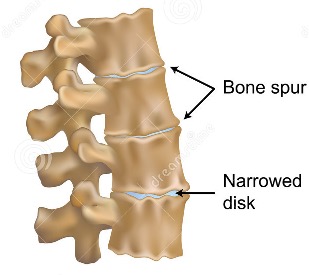Managing your nutrition with an anti-inflammatory diet can help battle diseases including osteoarthritis
Osteoarthritis is the most common form of arthritis, that occurs when the protective cartilage that cushions the ends of the bones wears down over time. This disorder most commonly affects joints in your hands, knees, hips and spine.

Osteoarthritis in spine

Osteoarthritis in knee

Osteoarthritis in Hip
Osteoarthritis is the most common joint disease, affecting an estimated 10% of men and 18% of women over 60 years of age (Woolf et al., 2003).
Earlier on, OA was thought to be a “wear and tear” degenerative joint disease. The symptoms can usually be managed, although the damage to joints can’t be reversed. Staying active, maintaining a healthy weight and receiving certain treatments might slow progression of the disease and help improve pain and joint function.
Nowadays it is acknowledged that local and systemic inflammation play a key role in the disease progression and the emergence of pain. Therefore, diet works hand in hand with exercise and strengthening and makes up the first line treatment for osteoarthritis.
What causes inflammation?
Inflammation is a healthy response by our immune system. When a foreign invader enters the body such as bacteria, viruses, or allergens, or an injury occurs, our immune cells act quickly. We may sneeze or cough to rid the body of an offending agent. We may feel pain and swelling at the site of a cut or injury to signal us to be gentle with this delicate area. Blood flows in rapidly, which may produce warmth or redness. These are signs that our immune system is repairing damaged tissue or fighting invaders. As healing takes place, inflammation gradually subsides.
Inflammation becomes harmful when it is prolonged and begins to damage healthy cells. Another harmful form of inflammation can be due to genetic deviants causing the body’s immune system to constantly attack cells. This occurs with autoimmune disorders like lupus, fibromyalgia, multiple sclerosis, rheumatoid arthritis, type 1 diabetes, and Crohn’s disease.
Moreover, sometimes an unhealthy lifestyle from lack of exercise, high stress, and calorie-rich diets can trigger chronic low levels of inflammation throughout the entire body. This type of low-grade inflammation does not usually produce noticeable symptoms, but over time it can pave the pathway for chronic conditions like cardiovascular disease, non-alcoholic fatty liver disease, type 2 diabetes, Alzheimer’s disease, and certain cancers (e.g., breast, colon).
How can we reduce anti-inflammation?
An anti-inflammatory diet is promoted as one of the remedies to battle inflammation in the body.
An anti-inflammatory diet does not follow strict rules about calories or portion sizes. It suggests a variety of anti-inflammatory foods to eat daily, rather than focusing on eating one or two specific foods or nutrients. This ensures a greater variety of protective food components, some of which may work synergistically to boost immunity. These foods provide plant chemicals (phytochemicals), antioxidants, and fiber that prevent cellular stresses, inhibit inflammatory signals caused by the immune system, promote healthy gut microbiota, and slow down digestion to prevent surges in blood glucose. They may also favorably affect the composition of fat cells to further reduce inflammation.
Further details
To schedule an appointment with Nutritionist : Simran Nanwani, you can whatsapp us at +628118897970
To learn more about our physiotherapy services including home-visit treatments, you can visit our website or schedule an appointment directly as well.



